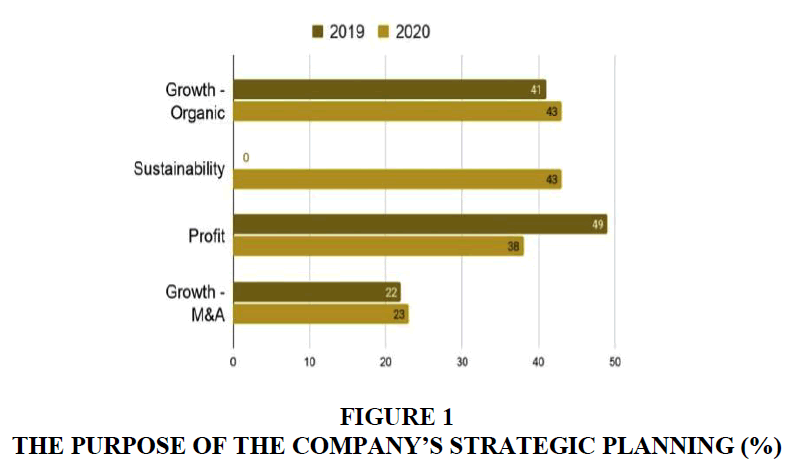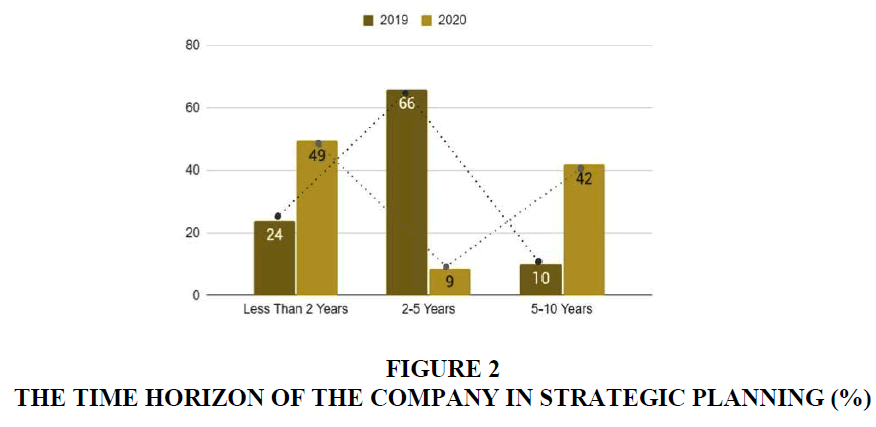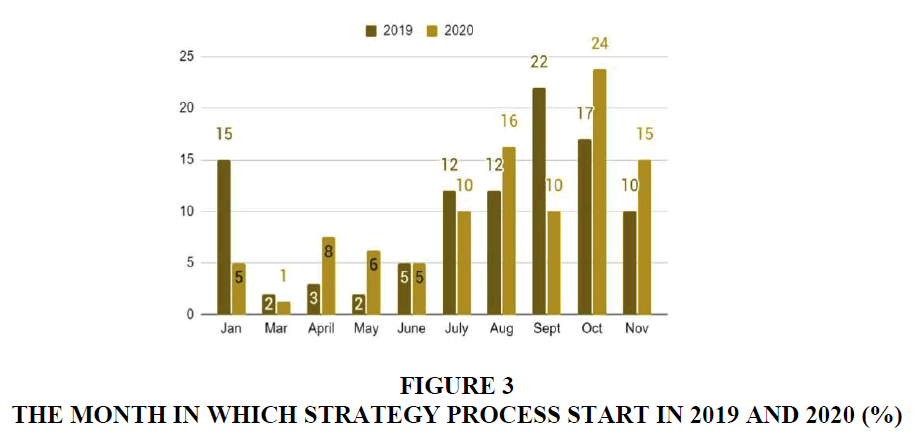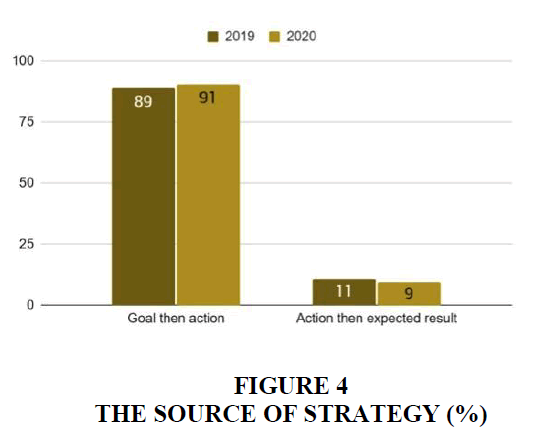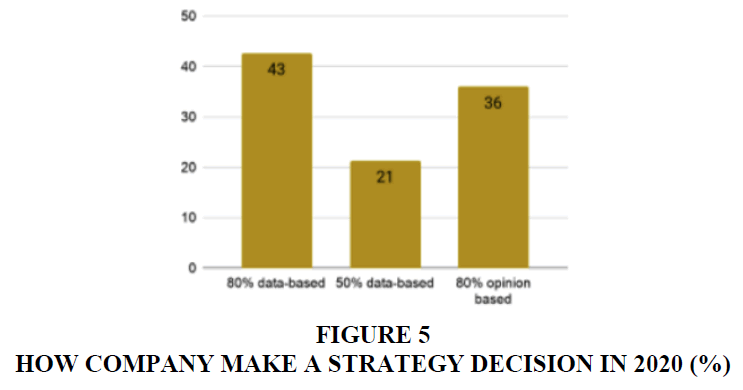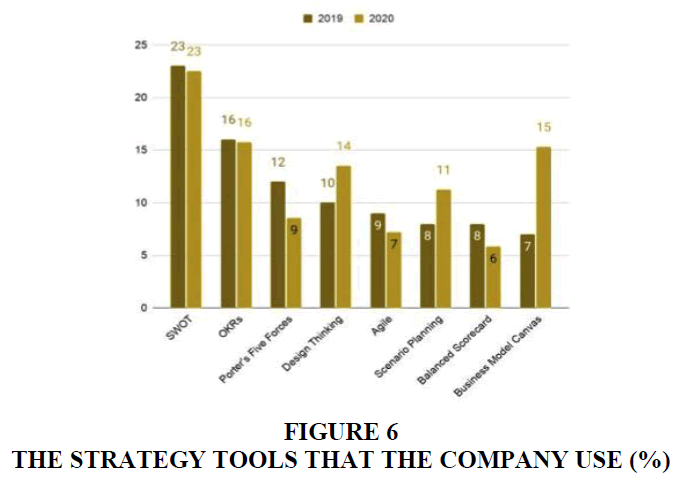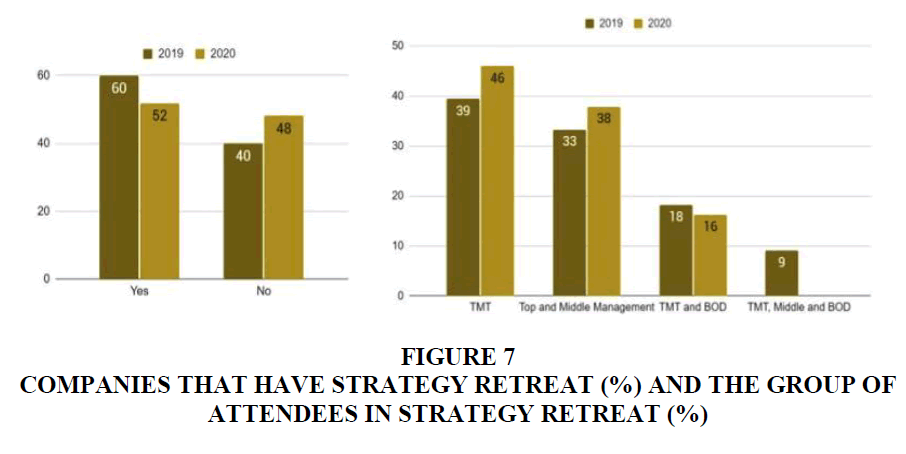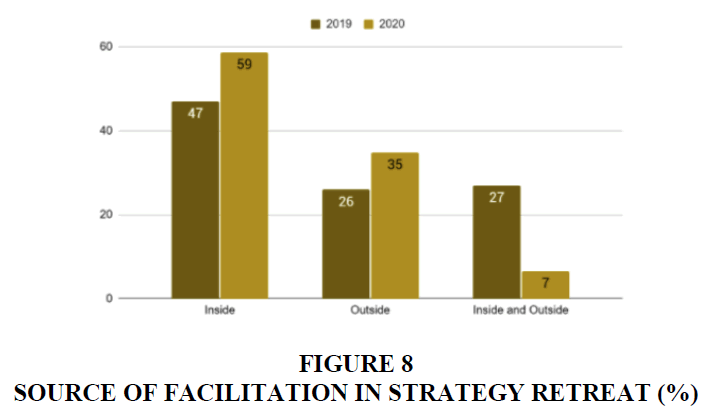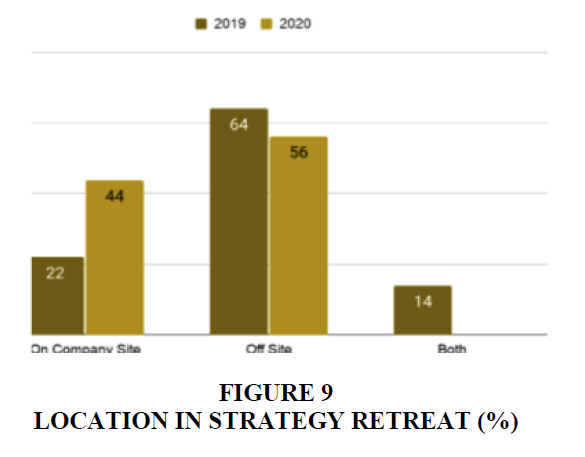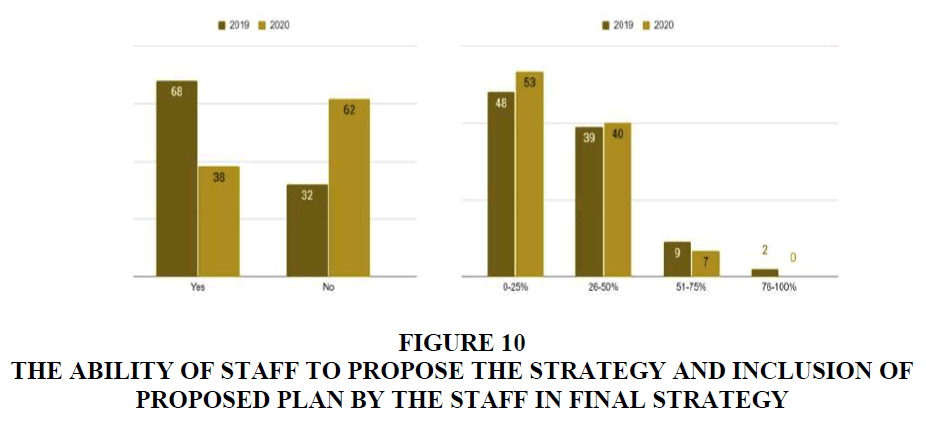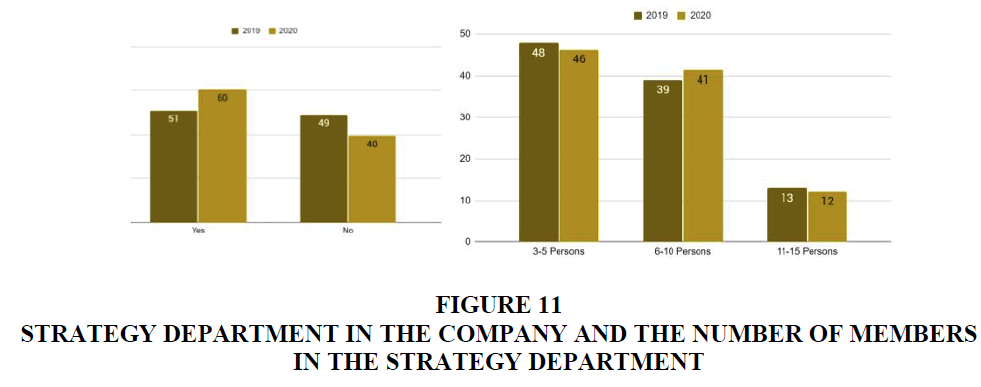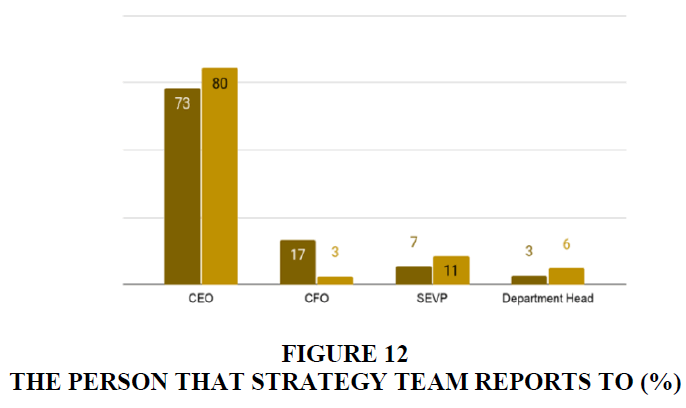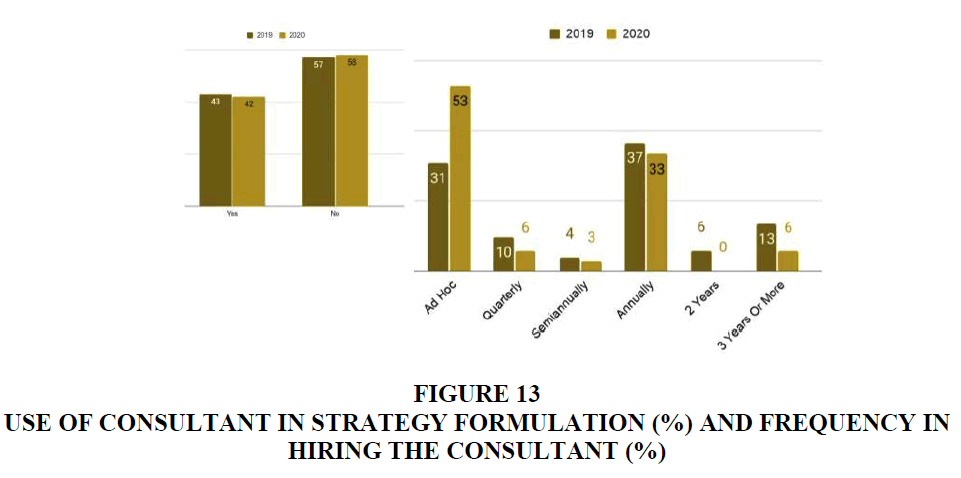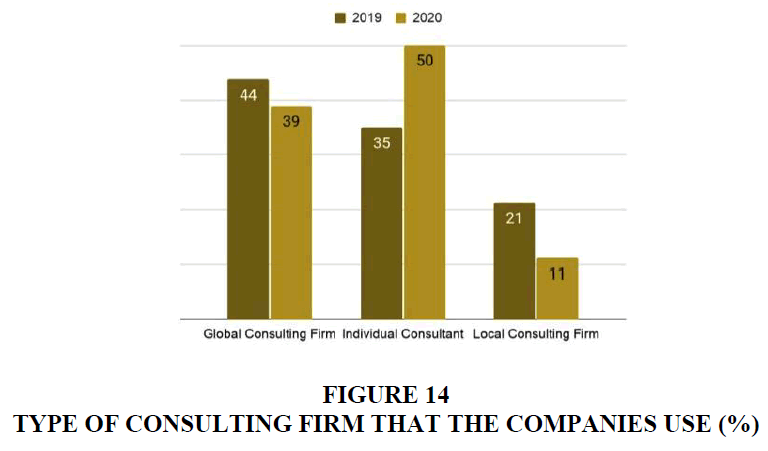Research Article: 2021 Vol: 20 Issue: 4
Strategic Management Practices in Thailand
Kulachet Mongkol, Srinakharinwirot University
Abstract
According to the Covid-19 crisis, the business environment changed rapidly. Strategic management and strategy formulation process of each company is needed to be adjusted to be suitable for the circumstance, and it is an absolutely interesting issue that should be addressed. This research aims to examine strategic management practices during 2019-2020 of firms that are listed in the Stock Exchange of Thailand in various aspects such as strategic planning, strategy approach, strategy tools, strategy retreat, and strategy execution. The results represent the body of knowledge about strategic management in Thailand. The subjects of the study included 237 Thai public limited companies. In particular to the methodology, questionnaires were used as a survey instrument, and descriptive analysis was conducted to examine the data and to provide updated results of strategic management practices of firms in Thailand. Interestingly, the results show that the majority of firms pay attention to organic growth and sustainability rather than short-term profit. In terms of strategy tools, situation analysis (SWOT) is still the most popular tool used in companies while business model canvas (BMC) and objectives and key results (OKRs) become more popular.
Keywords
Strategic Management, Strategic Management Practices, Strategic Planning.
Introduction
High competition among firms has rapidly increased in every industry. To be successful and gain more profit, effective strategic management is essential since it is a process in which organizations create firms' direction, analyze their internal and external environment, craft and execute strategies (Courtney, 2002; St. John & Harrison, 2014). In addition, the ultimate goal of strategic management is to generate a sustainable competitive advantage. Nevertheless, gaining a competitive advantage nowadays is getting more difficult. Furthermore, it is even more difficult to sustain once you have it. Many scholars (Campbell et al., 2011; Osterwalder & Pigneur, 2010; Porter & Advantage, 1985) agree that a company will be able to generate a competitive advantage when it effectively creates value to customers and effectively performs to meet customer demands in the meantime. To be successful in strategic management, strategic planning is extremely significant, and it has been a widely used process in business administration. It includes a long-term plan and goal setting, future analysis, and competitive thinking to work in a rapidly changing environment for the survival and growth of the organization.
Nowadays, competition in both Thai and foreign companies is intensifying to respond to the needs of customers as accurately as possible whether it is the aspect of excellent product quality, quantities, fast delivery, product availability, and economical cost. In 2019, the coronavirus (COVID-19) started having an impact on businesses around the world. Firms have been trying to keep their employees and customer safe, shoring up cash and liquidity as well as reorienting operations. Agility and Resilience are essential for them to survive from this pandemic and VUCA landscape (Volatility, Uncertainty, Complexity, Ambiguity). According to the crisis, strategic management and strategy formulation process of each company is different, and it is an absolutely interesting issue that should be addressed. This research presents important data on strategic practices in Thailand regarding strategic planning, strategy approach, strategy tools, and strategic planners from 237 organizations in Thailand. Results of the research would be beneficial, and allow us to understand the strategic management of companies in the Thai context.
Objectives of the Study
1. To study the strategic management process of firms that are listed in the Stock Exchange of Thailand
2. To present important data on strategic practices in Thailand
Literature Review
Strategic management involves the formulation and implementation of firms' objectives, goals, and initiatives taken by an organization's managers on behalf of stakeholders, based on consideration of limited resources and an assessment of the internal and external environments in which the organization operates (Alkhafaji, 2011; Courtney, 2002; Nag et al., 2007; Pfeffer & Salancik, 2009; Thompson et al., 2013). Strategic management provides overall direction to firms and involves specifying the organization's objectives, developing policies and plans to achieve those objectives and then firms must be able to effectively allocate resources to implement the plans (Rothaermel, 2018; Wheelen & Hunger, 2018). The main purpose of strategic management is to create a long-term competitive advantage, which can be done through both proactive and reactive measures. Many academics such as Adefe et al. (2019); Bayo-Moriones et al. (2021); Hamid (2018); Wheelen & Hunger (2018) confirms that a corporation can get a competitive edge by acting as a value creator and performing well to meet client needs while some researchers such as Atko?i?nien? & Miroshnychenko (2019) argue that knowledge and innovation are necessary for competitive advantage and sustainable development. Furthermore, Nimsith et al. (2016) contend that the key to achieving long-term competitive advantage is to execute each step of the firm’s value chain correctly. Competitive advantage must fundamentally be one that not only outperforms its competitors in terms of performance, but also provides true value to the client, ensuring a dominant position in the market. Additionally, effective strategic management would finally allow firms to have a competitive advantage and gain more profit (Porter, 1980; Porter & Advantage, 1985). Therefore, to gain a competitive advantage and to be successful in the industry, scholars and practitioners have developed various models and frameworks to assist in strategic decision-making in the context of complex and uncertain environments and competitive dynamics (Ghemawat, 2002). Nevertheless, strategic management is a continuous process and must be taken into account every round of planning (Hill & Jones and Gareth, 2012).
Methodology
This study focuses on Thai public limited companies that are listed in Thailand’s Stock Exchange.
Population
The study population consisted of 573 public limited companies in Thailand.
Samples
According to the Krejcie & Morgan table (1970), the stratified sampling method is used to select 237 companies in 8 different industries, including agricultural products, consumer products, financial products, industrial products, property, and construction, resource and technology, services, and technology. Thus, 29 respondents were obtained from each industry.
Data Analysis
Since this research aims to provide current data of strategic management practices in Thailand, therefore, only descriptive statistics (percentage) is an essential method used for general analysis on respondents.
Results and Discussion
According to the purpose of strategic planning, the data signified that the majority of companies focused on organic growth (43%) rather than profit (38%) and growth from M&A (23%). The reason that many companies prioritize growth as their focal point is that Thai companies are normally managed by entrepreneurs, and for them, growth is more important than profit (Figure 1). Moreover, the results also show that companies (43%) pay a lot of attention to sustainability, and this could mean that they focus more on long-term thinking and planning rather than short-term profit.
Concerning the time horizon of strategic planning, the results show that 42 percent of respondents plan their strategies for the next 5-10 years in advance while 49 percent of respondents plan their strategies for only this current year and the following year. The rest of the respondents (9%) plan their strategies for the next 5-10 years (Figure 2). It is visible that in 2019, most Thai companies focus on short to medium-term planning, and pay less attention to long-term planning. Nevertheless, the short to medium-term planning has significantly decreased in 2020. Long-term planning in contrast has significantly increased. As we may know that thinking about the future has significantly gained importance since maximizing profit should no longer be the companies' sole concern or purpose. On the other hand, long-term planning could help companies to become proactive, bring about growth, and be sustainable in their industries. Therefore, it can be seen that many companies pay more attention to long-term thinking and planning. Nevertheless, many companies have to focus on short-term planning because Covid-19 has impacted their profit, thus, they need to focus on the current situation first.
Regarding the strategic planning period, it is found that companies commence conducting their strategic plan mainly in Oct (24%), followed by Aug (16%), Nov (15%), Sept (10%), July (10%), April (8%), May (6%), June (5%), Jan (5%), and Mar (5%) consecutively. Undoubtedly, most companies start conducting their strategic plan during the 3rd and the 4th quarter since it coincides with when the company’s budget is set up (Figure 3).
According to the strategy approach issue, the results in 2019 and 2020 are not significantly different. Almost all companies start planning their strategy process with defined goals (91%), then strategize actions (9%) (Figure 4). Generally, companies could start their strategy process by either defining goals or strategizing actions. Thai companies prefer to start the process with a defining goal. There is nothing wrong with this practice. The most essential point is that the goals or objectives must be very SMART (Specific, Measurable, Attainable, Relevant, Timeliness). Goals that are too high or too low are futile since they could lead to the ineffectiveness of organizations’ performance. To be effective, companies actually should start the strategy process by strategizing their actions since it allows companies to have more growth. To illustrate this point, Tesla would be a very good case study. In the beginning, Tesla focused exclusively on how to build quality cars rather than on profit (Musk, 2006). Therefore, the company has put the effort into developing its production, operations, and tried its best to deliver quality products to customers. Eventually, this finally helped Tesla to be exceptionally successful in the industry.
Regarding the strategy approach, it is found that decisions are made mainly by data (43%), by opinion (36%), and both data and opinion equally (21%) respectively (Figure 5). At this point, there are still a number of Thai companies, utilizing an opinion base. However, theoretically, making decisions by using opinion-based is not appropriate because decision-makers may rely abundantly upon feeling. In actuality, they should make decisions by data, facts, logic, and analysis instead, since data-based would help them to reduce any errors during decision-making.
In relation to strategy tools, in 2020, Situation Analysis (SWOT) is still the most popular tool (23%) used in Thai companies while Business Model Canvas (BMC) becomes a rising star (%). In addition, Objectives and Key Results (OKRs) (16%), Design Thinking (14%), Scenario Planning (11%), Porter’s Five Forces (9%), Agile (7%), Balanced Scorecard (6%) have been used respectively as strategic tools in companies (Figure 6). From the result, it can be concluded that SWOT still is a simple and classic tool used widely. However, BMC seems to be very popular lately due to the ease of use. However, companies that would like to focus on flexibility, teamwork and strategic alignment would use OKRs as a tool. In addition, Porter’s five forces model is used by companies that prefer to focus on industry’s competitiveness, while Design Thinking is quite well-known for companies that focus on developing innovation.
Interestingly, 52 percent of the respondents contend that there is a strategy retreat in their companies during the year, while 48 percent of them contend that there is no strategy retreat in their organizations (Figure 7). Of course, Covid-19 is one of the major causes of not having the strategy retreat. Additionally, regarding the companies that organize a strategy retreat, 46 percent of participants are mainly top management teams, 38 percent are top and middle management, 16 percent are the top management team and board of directors, and in 2020, none of the participants were top management team, middle-level management and board of directors. To illustrate the point, the strategy retreat is essential since it allows key persons in each company to spend quality time together (generally 2-3 days) outside their companies to set up the direction and formulate strategies. Nevertheless, the strategy retreat should not only consist of the top management teams but should also include the board of directors and some key persons in the middle management level since they represent the stakeholders.
Figure 7 Companies that have Strategy Retreat (%) and The Group of Attendees in Strategy Retreat (%)
In relation to the source of facilitator in strategy retreat, the research found that 59 percent of respondents utilize internal staff to execute the retreat while only 7 percent of respondents use both internal and external staff, and 35 percent of respondents use purely external staff to organize the retreat (Figure 8). There is no doubt that many firms prefer to use internal staff to execute the strategy retreat because they already have staff in strategic departments. Thus, staff in the department holds a clear understanding of the companies' information and also the employees. Therefore, it would be simple for them to organize the retreat. However, the possible downside of running the strategy retreat by internal staff is that it could lead to bias and transparency issues in the organization. Moreover, since internal staff is in sync with the company's vision, it may be a challenge for them to come up with new creative ideas. Therefore, it is recommended that firms should consider the benefits of using external staff to run the strategy retreat since they could be more neutral and have no bias when making decisions or considering important issues.
Regarding the venue for strategy retreat, data shows that 56 percent of respondents use off-site locations, while 44 percent choose to be on sites, and none of the participants selected both off sites and on-site settings (Figure 9). Whenever the pandemic is fully contained, the strategy retreat should be held outside of the company for the participants to pay full attention to the activity. Moreover, this would also help the participants to improve their collaboration. For example, this can build interactivity among executives which can lead to positive and smooth cooperation, less conflict, and ultimately benefit the company's success.
According to the subject matter of strategic planners, the results of 2019 and 2020 are significantly different. In 2020, the results show that the majority of companies (62%) do not receive their employees' ideas and perceptions while only 38 percent of respondents tend to listen to the employees' ideas and opinions (Figure 10). In relation to the result, it seems like many companies have become more centralized due to the pandemic crisis, and the top management level needs to be more agile and quickly respond to the crisis. Moreover, even though employees are capable to propose their ideas and opinions, 53% of the participants said that a limited portion of the proposed ideas (0-25%) have been used and incorporated into the company's final strategy. Next, 40% and 7% of they said that 28-50% and 51-75%, respectively, of the proposed ideas, were included in the final strategy. To illustrate the point, the reason that many employees' proposed ideas have not been adopted is that executives may not be confident about the quality of the projected ideas. This stemmed from the lack of trust in their staff's knowledge regarding strategy. Therefore, to solve this problem, companies should invest in learning and development for their employees by developing their strategic thinking and planning skills.
Figure 10 The Ability of Staff to Propose The Strategy and Inclusion of Proposed Plan by the Staff in Final Strategy
Surprisingly, in 2020, the results show that there are 60 percent of the respondents have a strategy department in their companies. In relation to the strategy department, the number of staff are 3-5 members (46%), 6-10 members (41%), and 11-15 members (12%) consecutively. The strategy department is highly essential for a company (Figure 11). However, the appropriate number of members may depend upon the tasks and responsibilities in each corporation. For instance, some company may have a large team due to the vast responsibility in strategic planning for budgets, Program Management Office (PMO), or KPI.
In relation to the person who the strategy team reports to, it is found that the majority of respondents (80%) report directly to the CEO. (Figure 12) The rest of the respondents report to SEVP (11%), department head (6%), and CFO (3%) respectively. It can be seen that the chief strategy officers generally act as the right - hand man of the CEO. Thus, they tend to report directly to the CEO rather than someone else.
According to strategic consulting, the results show that 58 percent of respondents do not use external consultants, and only 42 percent of respondents have an external consultant. There are 53 percent of firms that hire consultants for specific reasons, and only 6 percent of firms hire consultants to advice for their 3 years plan. While other firms hire consultants to advice for every quarter (6 percent), half-year (3 percent), and 1 year (33 percent) respectively (Figure 13). It can be concluded that consultants are quite essential for Thai companies because they are the third party who have in-depth experience and are capable to help firms plan their long-term future vision effectively.
According to the type of consultancy, the research found that the majority of respondents (39%) hire a global consulting firm. While individual consultants (50%) and local consulting firms (11%) are also hired respectively. In 2020, Individual consultants are the most popular because they tend to have a long-term relationship with companies rather than global consulting firms (Figure 14). In the meantime, companies can be economical by not hiring global consulting firms. However, global consulting firms are still preferred because they are reliable professionals, and generally have high-profile staff that is capable of solving complex problems as well as giving effective recommendations for companies. Moreover, big companies also prefer to hire consulting firms that represent a strong reputation with expertise in branding.
Recommendation
1. The business environment has rapidly been changed due to the volatility, uncertainty, complexity, and ambiguity of circumstances. Therefore, firms should focus on the organization's agility and resilience to gain a competitive advantage.
2. Since the future is unpredictable and is difficult to anticipate, thus, rather than the traditional SWOT analysis, business executives should focus more on another contemporary strategy tools such as strategic foresight and scenario planning because these strategy tools could help them to capture new opportunities as well as decreasing business risk.
References
- Adefe, K., Watson, D., & Liddle, J. (2019). Do competency frameworks influence business performance? An empirical study of the Nigerian banking sector. International Journal of HRD Practice, Policy and Research, 4(1).
- Alkhafaji, A.F. (2011). Strategic management: formulation, implementation, and control in a dynamic environment. Development and Learning in Organizations: An International Journal.
- Atko?i?nien?, Z.O., & Miroshnychenko, O. (2019). Towards sustainable development: the role of r&d spillovers in innovation development. Journal of Security & Sustainability Issues, 9(2).
- Bayo-Moriones, A., Galdon-Sanchez, J.E., & Martinez-de-Morentin, S. (2020). Business strategy, performance appraisal and organizational results. Personnel Review.
- Campbell, D., Edgar, D., & Stonehouse, G. (2011). Business strategy: an introduction. Macmillan International Higher Education.
- Courtney, R. (2002). Strategic management for nonprofit organizations. Routledge.
- Ghemawat, P. (2002). Competition and business strategy in historical perspective. Business History Review, 76(1), 37-74.
- Hill, C., & Jones, G. (2012). Strategic management cases: an integrated approach. Nelson Education.
- Krejcie, R.V., & Morgan, D.W. (1970). Determining sample size for research activities. Educational and Psychological Measurement, 30(3), 607-610.
- Musk, E., (2006). The secret Tesla Motors master plan. Retrieved March 7, 2021, from https://www.tesla.com/blog/secret-tesla-motors-master-plan-just-between-you-and-me
- Nag, R., Hambrick, D.C., & Chen, M.J. (2007). What is strategic management, really? Inductive derivation of a consensus definition of the field. Strategic Management Journal, 28(9), 935-955.
- Nimsith, S.I., Rifas, A.H., & Cader, M.J.A. (2016). Impact of core competency on competitive advantage of banking firms in Sri Lanka. International Journal of Scientific Research and Innovative Technology, 3(7), 64-72.
- Osterwalder, A., & Pigneur, Y. (2010). Business model generation: a handbook for visionaries, game changers, and challengers. John Wiley & Sons.
- Pfeffer, J., & Salancik, G. R. (2009). The external control of organizations. A resource dependence perspective.
- Porter, M.E. (1980). Competitive Strategy, New York Free Press. Porter Competitive Strategy1980 .
- Porter, M.E., & Advantage, C. (1985). Creating and sustaining superior performance. Competitive Advantage, 167, 167-206.
- Rothaermel, F.T. (2018). Strategic management: Concepts (Vol. 2). Dubuque, IA: McGraw-Hill Education.
- St. John, H.C., & Harrison, S.J. (2014). Strategic management fundamentals. South-Western: Cengage Learning.
- Thompson, A., Janes, A., Peteraf, M., Sutton, C., Gamble, J., & Strickland, A. (2013). EBOOK: Crafting and executing strategy: The quest for competitive advantage: Concepts and cases. McGraw hill.
- Wheelen, L.T., & Hunger D.J. (2018). Strategic management and business policy. New Jersey: Pearson Education, Inc.
